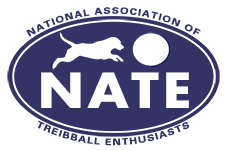-
-
-
-
-
-
-
-
Foundation Skills
-
-
-
-
-
-
-
-
 |
|
Foundation Skills
The foundation basic skills presented below are some of the most important for successful teams in Treibball. We strongly recommend that those starting Treibball have completed a good basic obedience class. After all, it's the foundation for everything we do with our dogs. As always, we only promote force-free training methods.
Our goal here is not to replace that basic obedience class but rather to augment how to teach or strengthen the skills helpful for Treibball. We also include some skills not generally taught in basic obedience. The Skills we cover on this page are:
- Eye Contact
- Down
- Go to Mat
- Fading the Mat
- Recall
- Rewarding
As a bonus we offer some advice on choosing verbal cues wisely!
|
|
Go To Mat
An indispensable skill for the dog is loving to Go To Mat. Mat training is one type of target training. It's a visual cue to help the dog know where we would like it to go. The mat is a place the dog is highly rewarded, so they want to go there. It's a great aid to have behind a ball when we start to add distance to encourage the dog to go further out on the field.
NATE devoted an entire Clubhouse Chat to The Power of Mats. This recording has a group discussion on using mats led by Chris Roeder. The primary discussion starts at the 20:36 min mark. The discussion portion on Fading the Mat was excerpted as its own video in the next section below.
NOTE: Personal preference plays a part when teaching the mat game. You can choose to train your dog to stand, sit, or lie down on the mat. There is no requirement for any particular position when your dog runs out behind the ball, so train what works best for you and your dog.
In the adjacent videos, Monica Pielage shows how she introduces a dog to the value of a mat and then adds a cue. In the second video she adds distance by rewarding the dog behind the Mat. The Lilly Pad Game helps to reinforce following the handler's directions to move from mat to mat. This foundation exercise is a fun game to help the dog learn to go to a mat. As with any game, five repetitions is enough to start with and then take a play break. Soon your dog will be running to the mats with more distance and speed. Eventually, the ball will become the target and the mat will be faded out. Add this to your early training or go back and play it if you see your dog slowing down. You can play it with any number of mats 2 to 10. Thank you to Sandi Pensinger for submitting this video. |
|
|
|
|